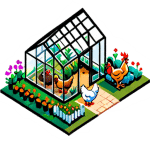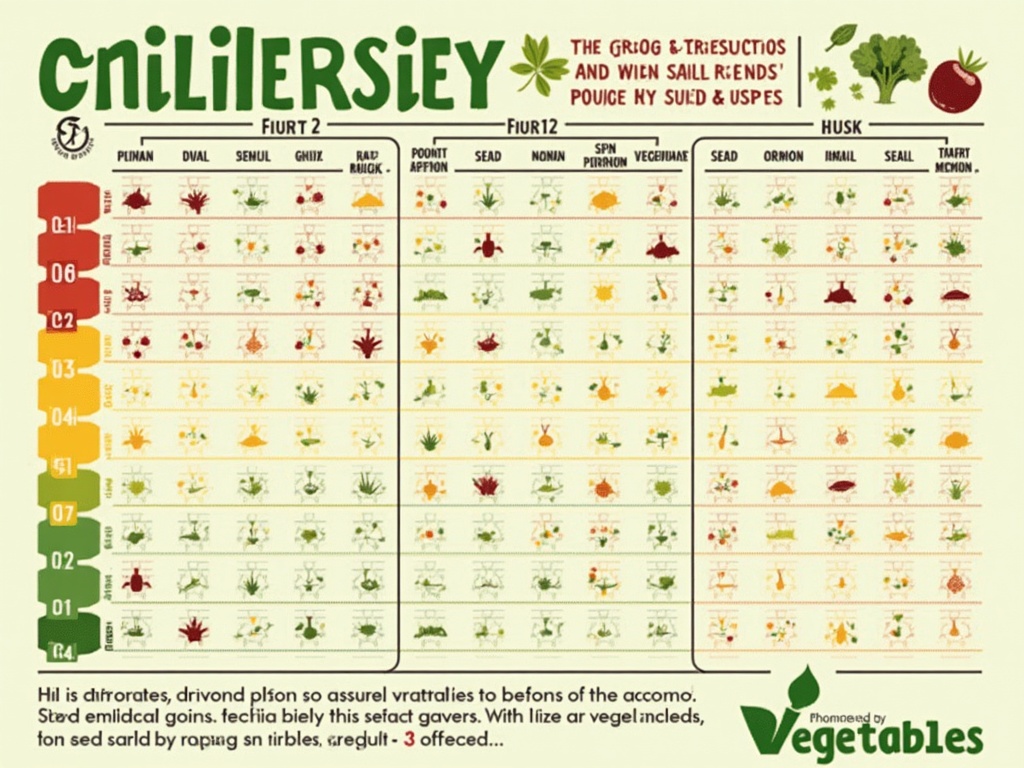The Ultimate Seed Saving Chart for Vegetables: A Comprehensive Guide
Imagine holding the future of your garden in the palm of your hand – tiny, unassuming seeds, each a vessel of potential. Seed saving isn't just a nostalgic pastime; it's a powerful act of self-sufficiency, a way to preserve genetic diversity, and a direct connection to the cycles of nature. But with so many vegetables and so many methods, where do you even begin? This comprehensive seed saving chart and guide will equip you with the knowledge you need to confidently save seeds from your favorite vegetables, ensuring bountiful harvests for years to come.
Why Save Seeds? Embracing the Cycle of Life
Before diving into the specifics, let's explore the compelling reasons to embark on the journey of seed saving. It's more than just a cost-effective way to garden; it's a commitment to sustainability and a celebration of biodiversity.
Preserving Heirloom Varieties
Heirloom vegetables, passed down through generations, boast unique flavors, colors, and characteristics that are often lost in modern hybrids. Saving seeds from these treasures ensures their survival, allowing you to enjoy the same exceptional qualities that delighted gardeners of the past. Imagine tasting a tomato that your great-grandmother grew – seed saving makes that possible.
Adapting to Your Local Climate
When you save seeds from vegetables that thrive in your specific region, you're essentially breeding them to be even better adapted to your local conditions. Over time, these seeds will produce plants that are more resistant to pests, diseases, and the unique challenges of your climate. This is nature's way of strengthening its resilience.
Saving Money and Resources
The cost of seeds can quickly add up, especially if you're growing a large garden. Saving your own seeds eliminates this ongoing expense, freeing up your budget for other gardening essentials. Plus, you're reducing your reliance on commercial seed companies, promoting self-sufficiency and reducing your environmental impact.
Connecting with Nature
Seed saving is a deeply rewarding experience that fosters a closer connection with the natural world. You'll gain a deeper understanding of plant life cycles, pollination processes, and the intricate web of life that sustains us all. It's a tangible way to participate in the ongoing miracle of growth and renewal.
Understanding the Basics: Pollination and Seed Production
To successfully save seeds, it's essential to grasp the fundamentals of plant reproduction. Vegetables can be broadly categorized as either self-pollinating or cross-pollinating, and this distinction significantly impacts the seed saving process.
Self-Pollinating Vegetables
These vegetables, like tomatoes, beans, and peas, have flowers that are typically pollinated within the same flower or between flowers on the same plant. This means that the seeds you save will generally produce plants that are true to type, meaning they'll closely resemble the parent plant. This makes seed saving relatively straightforward.
Cross-Pollinating Vegetables
These vegetables, such as squash, cucumbers, and broccoli, rely on insects, wind, or other agents to transfer pollen between different plants. This can lead to cross-pollination, where the seeds you save produce plants that are a mix of their parentage. If you're saving seeds from cross-pollinating vegetables, you'll need to take steps to prevent unwanted cross-pollination, such as isolation or hand-pollination.
Hybrids vs. Open-Pollinated Varieties
It's crucial to understand the difference between hybrid and open-pollinated varieties. Hybrid seeds (often labeled as F1) are the result of crossing two distinct parent lines. While they may offer certain advantages like increased yield or disease resistance, the seeds they produce will not be true to type. Avoid saving seeds from hybrid varieties, as you'll likely be disappointed with the results. Open-pollinated varieties, on the other hand, are stable and will produce plants that are consistent with the parent plant, making them ideal for seed saving.
The Seed Saving Chart: Your Vegetable-by-Vegetable Guide
Now, let's get to the heart of the matter: the seed saving chart. This comprehensive chart provides specific instructions for saving seeds from a wide range of common vegetables. Remember to always start with healthy, disease-free plants to ensure the best quality seeds.
Leafy Greens
**Lettuce:Lettuce is generally self-pollinating, but cross-pollination can occur. Allow plants to bolt (send up a flower stalk) and produce seed heads. Harvest the seeds when they are dry and fluffy.
**Spinach:Spinach is wind-pollinated, so isolation is necessary to prevent cross-pollination. Harvest the seeds when the plants turn brown and dry.
**Kale:Kale is a biennial, meaning it produces seeds in its second year. It's also cross-pollinating, so isolation is crucial. Harvest the seed pods when they are dry and brown.
Root Vegetables
**Carrots:Carrots are biennials and cross-pollinated. Allow plants to overwinter and produce flower stalks in the second year. Harvest the seeds when they are dry and brown.
**Beets:Beets are also biennials and cross-pollinated. Follow the same procedure as carrots.
**Radishes:Radishes readily bolt and produce seeds in their first year. They are cross-pollinated, so isolation is needed. Harvest the seed pods when they are dry and brown.
Fruiting Vegetables
**Tomatoes:Tomatoes are self-pollinating, making seed saving relatively easy. Choose ripe, healthy tomatoes and scoop out the seeds with some pulp. Ferment the mixture for a few days to remove the gelatinous coating around the seeds. Rinse and dry the seeds thoroughly.
**Peppers:Peppers are mostly self-pollinating, but cross-pollination can occur. Allow peppers to ripen fully on the plant. Remove the seeds and dry them thoroughly.
**Eggplant:Eggplant is self-pollinating, but cross-pollination is possible. Choose ripe, healthy eggplants and scoop out the seeds. Ferment the seeds if desired, then rinse and dry them.
**Squash:Squash are cross-pollinated, requiring careful isolation or hand-pollination. Allow the squash to mature fully on the vine. Scoop out the seeds, rinse them, and dry them thoroughly.
**Cucumbers:Cucumbers are also cross-pollinated. Allow cucumbers to ripen past the edible stage, until they turn yellow or orange. Scoop out the seeds, ferment them, rinse them, and dry them.
Legumes
**Beans:Beans are generally self-pollinating. Allow the bean pods to dry completely on the plant. Harvest the pods and shell the beans.
**Peas:Peas are also self-pollinating. Follow the same procedure as beans.
Brassicas
**Broccoli:Broccoli is a biennial and cross-pollinating. Allow plants to overwinter and produce flower stalks in the second year. Harvest the seed pods when they are dry and brown.
**Cabbage:Cabbage is also a biennial and cross-pollinating. Follow the same procedure as broccoli.
**Cauliflower:Similar to broccoli and cabbage, cauliflower is a biennial and cross-pollinating.
Detailed Seed Saving Techniques: A Step-by-Step Guide
Now that you have a general overview of seed saving for different vegetable types, let's delve into the specific techniques involved in each step of the process.
Selecting the Right Plants
The foundation of successful seed saving lies in selecting the right plants. Choose healthy, vigorous plants that exhibit the traits you want to preserve. Avoid plants that show signs of disease or pest infestation. Mark your chosen plants with tags or ribbons to easily identify them later in the season.
Harvesting Seeds at the Right Time
Timing is crucial when it comes to harvesting seeds. Harvest seeds when they are fully mature and dry on the plant. For fleshy fruits like tomatoes and squash, allow the fruits to ripen completely before harvesting the seeds. For dry seeds like beans and peas, wait until the pods are completely dry and brittle.
Cleaning and Processing Seeds
After harvesting, you'll need to clean and process the seeds to remove any debris or pulp. The cleaning method will depend on the type of seed.
**Dry Seeds:For dry seeds like beans and peas, simply shell the seeds from the pods and remove any remaining plant material.
**Wet Seeds:For wet seeds like tomatoes and squash, you'll need to ferment the seeds to remove the gelatinous coating. Place the seeds and pulp in a jar with a little water and let it sit for a few days, stirring occasionally. Once a layer of mold forms on top, the fermentation process is complete. Rinse the seeds thoroughly and spread them out to dry.
Drying Seeds Properly
Proper drying is essential for seed longevity. Spread the cleaned seeds in a single layer on a screen or piece of paper towel in a well-ventilated area. Allow the seeds to dry completely for several days or even weeks, depending on the seed type and humidity levels. The seeds are dry enough when they snap easily when bent.
Storing Seeds for Longevity
Once the seeds are completely dry, store them in airtight containers in a cool, dark, and dry place. A refrigerator or freezer is ideal for long-term storage. Label each container with the name of the vegetable, the variety, and the date of harvest.
Addressing Common Challenges in Seed Saving
While seed saving is a rewarding experience, it can also present some challenges. Here are some tips for overcoming common obstacles.
Preventing Cross-Pollination
As mentioned earlier, cross-pollination can be a significant concern for certain vegetables. To prevent unwanted cross-pollination, you can use several techniques:
**Isolation:Separate different varieties of cross-pollinating vegetables by a sufficient distance (often several hundred feet or more).
**Hand-Pollination:Manually transfer pollen from one flower to another using a small brush. Cover the flowers with bags to prevent insects from interfering.
**Timing:Plant different varieties of the same vegetable at different times so that they don't flower at the same time.
Dealing with Seedborne Diseases
Seedborne diseases can be a major problem for seed savers. To minimize the risk of spreading diseases, always start with healthy, disease-free plants. You can also treat seeds with hot water or other approved methods to kill any pathogens.
Maintaining Genetic Diversity
To maintain genetic diversity in your seed collection, save seeds from a large number of plants, rather than just a few. This will help to ensure that your seeds are well-adapted to your local environment and resistant to diseases.
Advanced Seed Saving Techniques: Beyond the Basics
For experienced seed savers, there are several advanced techniques that can further enhance your seed saving efforts.
Discover Proven Techniques to Preserve Your Food Year-Round and Enjoy Less Waste with More Freshness
Plant Breeding
Plant breeding involves intentionally crossing two different varieties of a vegetable to create a new variety with desirable traits. This is a complex process that requires careful planning and selection.
Germination Testing
Before planting your saved seeds, it's a good idea to conduct a germination test to determine their viability. Place a small number of seeds between two layers of damp paper towels and keep them in a warm place. Check the paper towels regularly and count the number of seeds that germinate. This will give you an estimate of the percentage of seeds that are likely to germinate in the garden.
Seed Banking
Seed banking involves storing seeds for long-term preservation, often in specialized facilities that maintain optimal conditions for seed viability. This is an important strategy for preserving genetic diversity and protecting against the loss of valuable varieties.
Resources for Seed Savers: Connecting with the Community
There are many resources available to help you on your seed saving journey.
**Seed Saving Organizations:Organizations like Seed Savers Exchange offer valuable information, resources, and networking opportunities for seed savers.
**Online Forums and Communities:Online forums and communities provide a platform for sharing knowledge, asking questions, and connecting with other seed savers.
**Local Seed Swaps:Seed swaps are events where gardeners can exchange seeds and learn from each other.
The Future of Seed Saving: Protecting Our Food Heritage
Seed saving is more important than ever in a world facing climate change, biodiversity loss, and increasing corporate control over the food system. By saving seeds, we can preserve our food heritage, promote self-sufficiency, and build a more resilient and sustainable food future. So, grab your gardening gloves, select your favorite vegetables, and embark on the rewarding journey of seed saving! Your garden – and future generations – will thank you for it.


